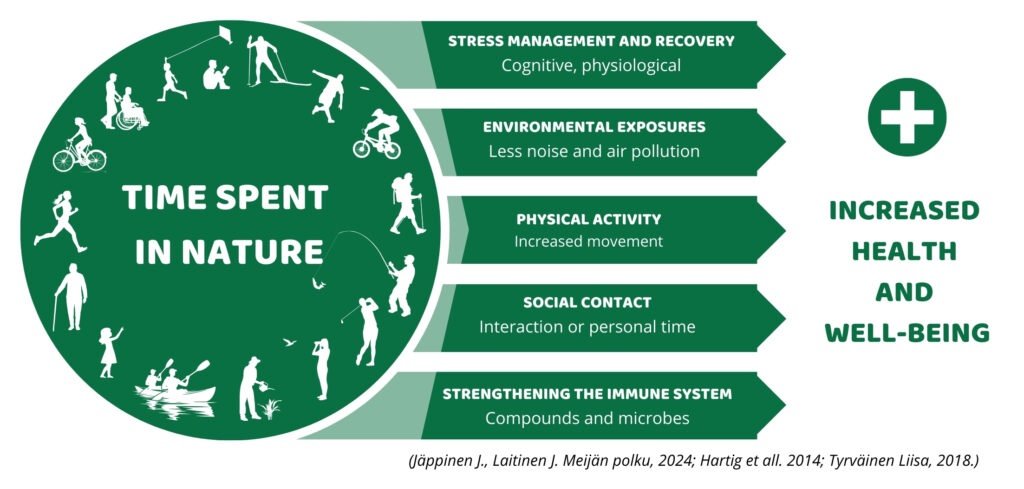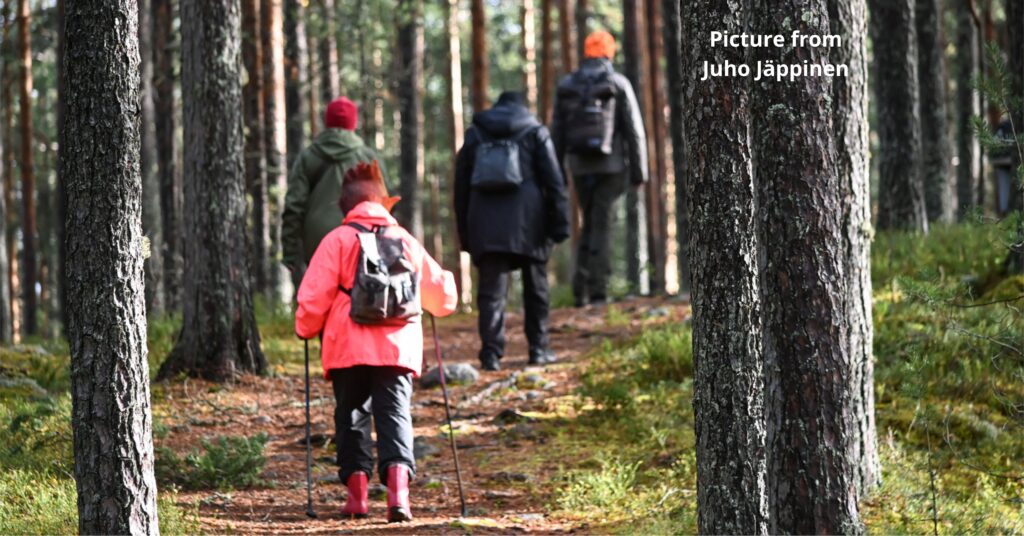National parks as promoters of stays and exercise in nature
Finland’s adoption of the 3-30-300 Nature Recommendation in 2025, promoting outdoor exercise and nature engagement, is the focus of this guest article by Juho Jäppinen. The 3-30-300 model encourages visiting nature 3 times a week for at least 30 mins each time, aiming for 300 mins weekly. This initiative encourages physical activity and nature connectedness.
Juho Jäppinen is both author of the 3-30-300 Nature Recommendation and promoter of connectedness with nature and physical activity through Meijän Polku, “Our Path” promoting community health and wellbeing.
In early 2025, the 3–30–300 Nature Recommendation was published in Finland to promote spending time in nature and outdoor exercise. The Nature Recommendation was inspired by the 3-30-300 model (https://www.330300rule.com) that has attracted a great deal of attention in urban planning in recent years. As a Nature Recommendation, the 3-30-300 model offers an easy-to-remember rule for exercise and spending time in nature:
- Visit nature at least 3 times a week.
- Spend at least 30 minutes at a time in nature.
- Aim at spending a total of 300 minutes in nature every week.
The 3-30-300 Nature Recommendation also advocates combining the 300 minutes spent in a natural environment with brisk physical activity. This allows you to maximise the wellbeing and health benefits of both exercise and natural environments. Spending time in nature and outdoor exercise can be effortlessly combined in national parks, where people spend more time and go on longer excursions. There is a great need to increase physical activity and time spent in nature in Finland, Europe and elsewhere in the world.
 Image – Kuvateksti: Humans derive wellbeing and health benefits from nature through different mechanisms. The time spent in diverse natural environments and the frequency and recurrence of exposure to nature are important from the perspective of increased wellbeing. This is why the 3-30-300 Nature Recommendation advises people to visit natural environments at least 3 times a week for at least 30 minutes at a time and sets the weekly target of 300 minutes in total. In national parks and other larger areas intended for outdoor activities, you can achieve the 300-minute weekly target on a single visit.
Image – Kuvateksti: Humans derive wellbeing and health benefits from nature through different mechanisms. The time spent in diverse natural environments and the frequency and recurrence of exposure to nature are important from the perspective of increased wellbeing. This is why the 3-30-300 Nature Recommendation advises people to visit natural environments at least 3 times a week for at least 30 minutes at a time and sets the weekly target of 300 minutes in total. In national parks and other larger areas intended for outdoor activities, you can achieve the 300-minute weekly target on a single visit.
Back to nature
Finns are known as a people living close to nature. However, our relationships with nature vary a great deal depending on such factors as where we live and what age we are. Around 4% take no outdoor exercise, and about one out of three Finns do so once a week or less frequently. (LVVI3)
At the European level, the demand for the wellbeing and health benefits of spending time and exercising in nature would be even greater, as almost one half of Europeans engage in no physical activity at all. Only one half of those who engage in physical activity exercise in parks or other outdoor environments. (Special Eurobarometer 525).
Urbanisation, motorization and our changing lifestyles have significantly reduced our contacts with diverse nature. In the meantime biodiversity around us is disappearing, which contributes to reducing our wellbeing. (Hanski et al.2012).
We suffer from nature deficiency, the effects of which are seen as the rising prevalence of lifestyle diseases, including mental health problems, obesity, cardiovascular diseases, type 2 diabetes and cancers. This is why spending more time and being physically active in nature would be increasingly important for not only public health but also the national economy.
According to Finnish estimates, the health economic value of natural environments is approx. EUR 2.5 billion annually. (Tyrväinen et al. 2024) It has been estimated that by reducing sedentary behaviour, in other words being physically active, we could save EUR 3.2 billion a year in health expenses in Finland. (Kolu et al. 2022) While exposure to nature and increase in physical activity largely take place close to home, national parks do and could play a major role in promoting wellbeing and health.

National parks’ role in increasing the length of stays and fostering our relationship with nature
National parks generally differ from local natural environments near our homes in terms of their scale, biodiversity and location; large and connected areas of protected nature are usually located at a distance from urban centres. This is also true in Finland. For example, the four national parks in Central Finland are located 50 to 120 km from Jyväskylä, the largest city in the region with 150,000 residents.
The remote location not only creates logistic challenges from the perspective of sustainable travel but also increases the visitors’ length of stay in the area – once you make your way to a national park, you stay there longer. For example, the average length of stay in Central Finland’s national parks, excluding overnight trips, is 3 to 5 hours, which in practice makes up the weekly total of the 3-30-300 Nature Recommendation.
National parks are also suitable destinations for overnight excursions. Such longer trips have increased in popularity, and in some Finnish national parks they already account for a significant proportion of visits.

Caption: Most people’s contacts with nature in Finland take place in their local environments, or less than 300 metres from home. However, a visit to natural sites further away from home usually lengthens the duration of individual visits and also enables new experiences of nature activities and outdoor exercise. In terms of accessibility, the longer distances are a challenge.
National parks are also excellent environments for developing connectedness with nature, building up knowledge of the natural environment, and gaining new experiences of hiking and exercise in nature. For example, many of us try longer hikes, overnight stays in nature, mountain biking, paddling or snowshoeing for the first time under the guidance of hiking and tourism entrepreneurs operating in national parks. National parks are also where many of us enjoy our first visits to old-growth forests with a high level of biodiversity.
The significant difference between national parks and local natural environments in residential areas is not only extensive nature areas with high biodiversity and various small ecosystems but also silence, darkness and the possibility of following a natural daily rhythm, which we rarely get to enjoy in urban areas and cities any more. Silence, the soundscape of nature and a natural daily rhythm improve human wellbeing but also enable holistic nature experiences.
There and back again
From the perspective of accessibility, improving public transport connections plays a key role for national parks. Positive signs of such services becoming available have been seen in recent years in Finland, and some of our national parks can be reached either by bus or train. Next summer, you can also get to the nearby national parks by bus from Jyväskylä. Among others, this makes visits to national parks possible for persons in a weaker social position, senior citizens and families with young children who have no private car. Spending more time in nature and taking more outdoor exercise have a significant impact on the wellbeing and health of these groups.
Better availability of public transport will reduce the loading and congestion of parking areas in national parks and, above all, environmental loading and emissions produced by visitors to national parks. Reaching natural environments without burdening the ecosystem should indeed be possible regardless of the visitor’s socio-economic background, age or state of health. The growing trend of cycling tourism should also be considered when improving the accessibility of national parks. Better public transport will also significantly reduce the noise and particulates in the air caused by private car use. While natural environments can absorb and filter anthropogenic noise and particulate matter from traffic, the busy road networks close to urban environments often mean that these disadvantages cannot be completely eliminated. National parks located at a distance from major traffic corridors already avoid most of these problems just by their location, and guiding transitions towards public transport and cycling tourism also reduces the disadvantages caused by private car use in the neighbouring areas of national parks.

To conclude
National parks offer a great opportunity for promoting exposure to nature, understanding of nature and exercise in nature. Consequently, the number and extent of national parks should be significantly increased in Finland and Europe in order to foster the wellbeing of both humans and nature. Increasing the number of national parks and expanding the size of existing areas will reduce wear and tear in them as visitors can choose between several similar sites. The accessibility of national parks with both public transport and bikes should similarly be improved in order to reduce the environmental footprint caused by transitions. In the meantime – in order to maximise the most significant potential for our wellbeing and health – we should also rapidly increase and diversify natural environments in our cities. At European level, the original 3-30-300 recommendation can be used as a good guideline for this work.